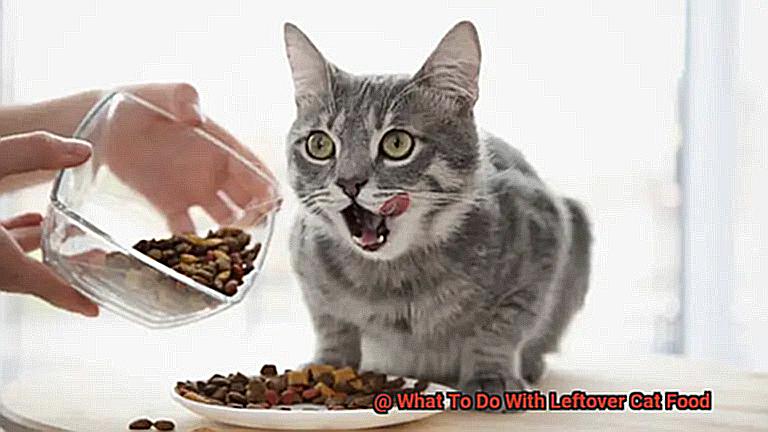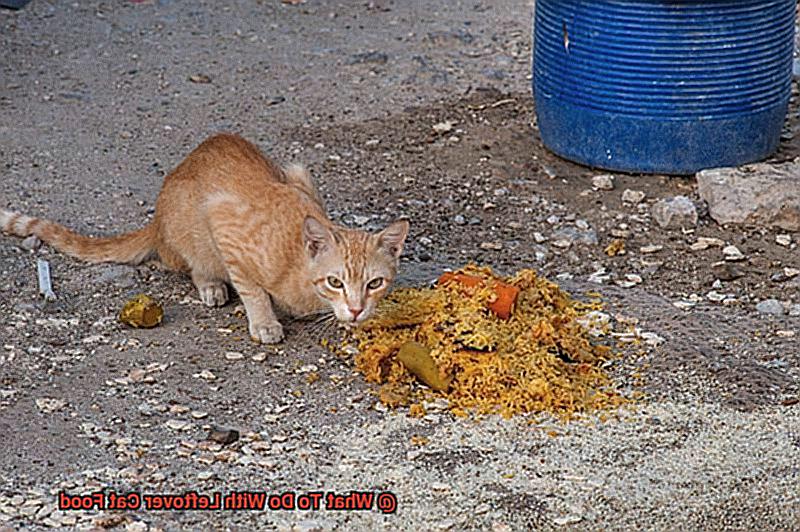Do you have a cat and find yourself with leftover cat food at the end of each meal? You’re not alone! Many pet owners struggle with leftovers, but it doesn’t have to be a challenge.
In this blog post, we’ll cover the best ways to store, repurpose, and even donate your extra kibble. From airtight containers to helping local shelters, you’ll learn how to make sure your feline friends’ food goes to good use.
Let’s get started!
Will Cats Eat Leftover Food?
The answer is yes, but there are a few things to consider. It all depends on how long the food has been sitting out and what type of food it is.
Canned wet food should be thrown away after two hours, as bacteria can grow quickly in moist environments. Dry kibble can usually be left out for up to 24 hours without any issues. If your cat doesn’t finish their meal, you can store it in a sealed container in the refrigerator for up to 48 hours.
Cats are creatures of habit, and if the food has been sitting out too long, they may not want to eat it. So, if you’re going to give your cat leftovers, make sure they haven’t been sitting out for more than two hours (for wet canned food) or 24 hours (for dry kibble).
Can You Save Half a Can of Cat Food?
All you need to do is store it properly.
Store the leftovers in an airtight container and place it in the refrigerator. This will help keep the food fresh and safe to eat later. Make sure to label the container with the date so you know when it was opened.
If the food has been left out at room temperature for more than two hours, discard it immediately. And if you plan on saving it for later, make sure to throw out any leftovers after 24 hours in the refrigerator.
Can You Reuse Dry Cat Food?
The answer is yes, but only under certain conditions.
To ensure that the food is still safe for your pet, make sure it has been stored in a cool, dry environment and is still within its expiration date. If these conditions are met, then you can safely reuse the food. However, if the food has been exposed to moisture or other contaminants, it should not be reused.
Before feeding your cat, inspect the food for any signs of mold or spoilage. Additionally, never open cans of wet cat food, as bacteria can quickly form and make your pet sick.
How to Store Leftover Dry Cat Food
Storing dry cat food properly is essential to ensuring that it stays fresh and is safe for your pet to eat. In this blog post, we’ll provide you with five tips on how to store leftover dry cat food so that your furry friend can enjoy every last morsel!
Store in an Airtight Container
The first step in storing dry cat food is to transfer the opened package into an airtight container or resealable bag. This will help keep the food fresh and prevent any spoilage or contamination from direct sunlight or humidity in your home environment. If possible, try a vacuum sealer to ensure that the food stays fresh for up to three months.
Keep Away from Direct Sunlight
When storing leftover dry cat food, make sure the container is away from direct sunlight and heat sources. This will help preserve the flavor and quality of the food, as well as prevent it from going stale or becoming contaminated by other elements in your home environment.
Store in a Cool, Dry Place
To keep the food fresh longer, consider storing the container in a cool, dry place like a pantry or cupboard. This will help maintain the quality of the food while also preventing any spoilage or contamination due to humidity or extreme temperatures.
Label Containers
It’s important that you label each container with the date of when you opened it so you know when it needs to be discarded if not used by then. This will help you keep track of how long each portion of food has been stored and prevent any unnecessary waste due to spoilage or contamination.
Freeze in Small Portions
If you have opened a package of dry cat food and don’t think it’ll all be eaten before it goes bad, consider freezing it in small portions instead of throwing out any unused portions of your pet’s meals.
Tips for Storing Fresh Wet Cat Food
Whether it’s fresh, canned, or frozen, proper storage is essential to keeping your cat’s wet food safe and delicious. Here are some helpful tips to ensure that your cat’s wet food is stored correctly.
For Fresh Wet Cat Food
Make sure the fresh, wet cat food is stored in an airtight container in the refrigerator for up to three days. This will help keep the food from spoiling and prevent waste. For longer-term storage, freeze the food in an airtight container for up to six months.
When reheating frozen cat food, make sure it is heated thoroughly and evenly for maximum safety and flavor.
Do not leave wet cat food out for more than two hours, as bacteria can develop quickly in moist environments.
For Canned Cat Food
Before opening a can of wet cat food, make sure to rinse it with hot water first. This will help prevent any bacteria from forming on the can’s surface. Additionally, label all cans of wet cat food according to when they were opened so that you know when they need to be discarded or not.
For Frozen Wet Cat Food
When freezing wet cat food, place it in an airtight container and store it for up to four months. To safely thaw frozen wet cat food, leave it out overnight in the refrigerator or use a microwave set on low heat.
Never refreeze thawed wet cat food, as this can lead to spoilage and contamination with bacteria that can make your pet sick.
The Benefits of Using Fresh Wet Cat Food
A balanced diet is essential for cats to stay healthy and happy, and wet cat food is an excellent way to provide them with the nutrition they need. It’s higher in moisture content than dry food, which helps keep cats hydrated and can help reduce the risk of urinary tract infections.

Plus, it’s more palatable than dry food, making it easier to encourage picky eaters to eat.
Cats that are fed wet food often have shinier coats, healthier skin, and better overall health. Wet cat food also has fewer calories than dry food, making it a great option for overweight cats.
When selecting wet cat food for your furry friend, look for high-quality ingredients such as real meat, fish, and vegetables.
Alternatives to Feeding Your Cat Leftovers
It can be a great way to save money and reduce food waste, but there are other options to ensure your cats get the best diet possible.
Investing in airtight food storage containers is a great start. This will help keep their food fresher for longer periods of time, providing them with all of the vitamins they need.

If you have extra cat food, consider freezing it in portions so you can use it when needed. Thawing it is quick and easy, and this method helps prevent any food from going to waste!
Get creative with the leftovers! Use them as treats or mix them in with other foods to make a nutritious meal that your cats will love. Experimenting with different flavors and textures can be fun as well!
Finally, try different types of cat food. There are plenty of options on the market that your cats might enjoy more than their current meals—and this could mean less leftover food for you.
Disposing of Unused Wet Cat Food
When it comes to disposing of unused wet cat food, the safest and most effective option is to throw it in the trash.
However, before doing so, make sure to seal the food in a container or bag to prevent animals from getting into it and potentially becoming ill. Pouring unused wet cat food down the drain should also be avoided, as this can cause clogs and other plumbing issues.
Finally, never leave empty cans of wet cat food outside, as this could attract wild animals such as raccoons, opossums, or bears.
Disposing of Unused Dry Cat Food
Unused dry cat food can be placed in a compost bin as long as it is not contaminated with any other ingredients.
If you’re throwing out large amounts of leftover cat food, contact your local waste disposal company for proper disposal instructions.
Alternatively, you can mix the dry cat food with other garbage and bury it in the ground or donate it to a local animal shelter, pet store, or rescue group.
Safety First
When disposing of any type of unused cat food, wet or dry, safety should always be a top priority.
Make sure to double bag all used cat food before throwing it away and placing it in a secure garbage can with a lid that cannot be opened by animals or rodents.
In addition, never leave unused cat food outside as this could attract wild animals such as raccoons, opossums, or bears, which may become sick if they eat the discarded food.
Why You Shouldn’t Throw Out Unused Wet or Dry Cat Food
There are several reasons why throwing out used wet or dry cat food is not recommended; Firstly, doing so will attract rodents and animals.
Second, leaving food outside can result in wild animals eating it and becoming ill.
Finally, improper disposal techniques can have long-term effects on our planet’s health if not done correctly.
Taking Care when Disposing Unused Cat Food
Taking care when disposing of any type of unused cat food is essential for both our pets’ wellbeing and our planet’s health! Make sure to double bag all used cat food before throwing it away and placing it in a secure garbage can with a lid that cannot be opened by animals or rodents.
Furthermore, use proper disposal techniques before disposing of large amounts of waste in order to do so safely and without negatively impacting your local environment.
Conclusion
Don’t let your cat’s leftovers go to waste! Shop, repurpose, and donate unused cat food for the best results. Wet canned food can stay in the fridge for up to 48 hours, while dry kibble can be stored for 24 hours.
Make sure it’s been kept in a cool, dry place and is still within its expiration date. Store opened cans of dry food in an airtight container away from direct sunlight and label with the date so that they can be recycled if not used.Frozen wet cat food should be stored in an airtight container for up to four months.
When disposing of used wet or dry cat food, always double bag it before throwing it away into a locked garbage can with a lid that cannot be opened by animals or rodents.
Consider donating unused cat food to local shelters, pet stores, or rescue groups so no meal goes uneaten.







